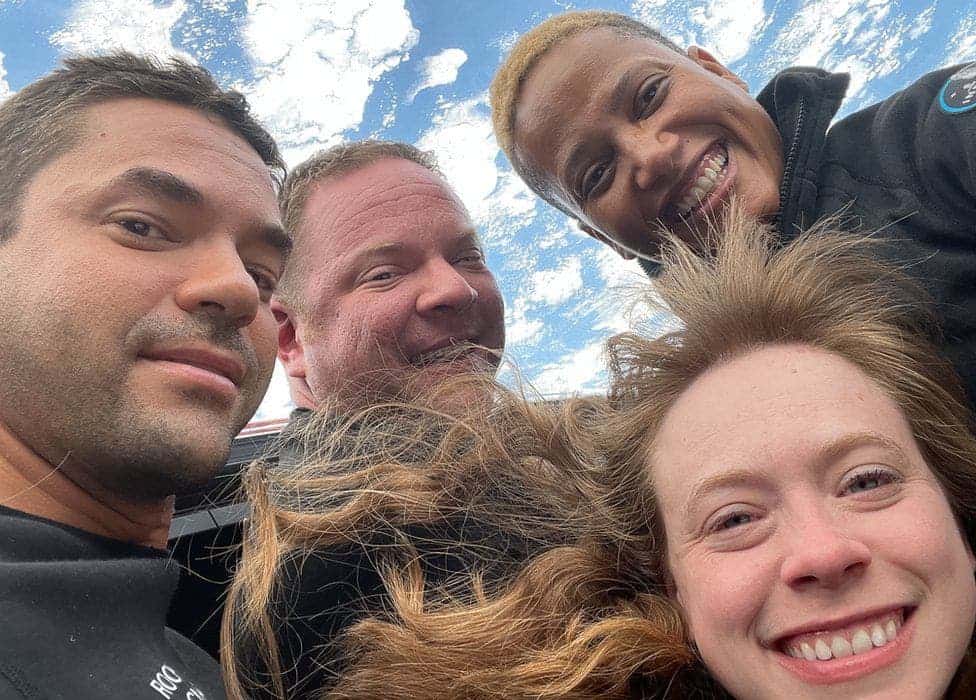Four amateur astronauts returned to Earth after a three-day space excursion on board of the SpaceX Crew Dragon capsule, the first flight to Earth’s orbit done entirely by tourists. The launch and return of the mission is the latest in recent expeditions financed by billionaire passengers and marks a milestone in the nascent astro-tourism industry.

Following an automated reentry to the Earth’s atmosphere, the group of unlikely astronauts that comprised the SpaceX Inspiration4 mission safely splashed down in the Atlantic near the coast of Florida last Saturday evening. Parachutes slowed the capsule’s descent before landing in the water, where boats from SpaceX were waiting for its retrieval.
The crew members were seen emerging from the capsule, visibly happy after the experience. They stood on the deck of a SpaceX recovery vessel, waved, and gave thumps-up before being taken to a medical station for checkups. Then they were flown by helicopter back to Cape Canaveral, where they were received by their families.
SpaceX, the spacecraft and rocket manufacturing company owned by billionaire Elon Musk, provided the spacecraft used for the mission, controlled the flight and managed the recovery of the capsule. The mission was funded by Jared Isaacman, an e-commerce entrepreneur, who paid for the four seats and was also the commander of the crew.
Isaacman was joined by three strangers he selected: geoscientist Sian Proctor, physician assistant Hayley Arceneaux, and Air Force veteran Chris Sembroski. The mission was conceived to raise awareness and donations for St. Jude’s Children Research Hospital, which works to defeats childhood cancer and other life-threatening diseases. So far $160 million were raised, including $100 million donated by Isaacman.
During the mission, the crew members chat with their families, admired the amazing views from space, and listened to some music. During a live stream on Friday, Proctor showed some artwork he did during her stay with metallic markers, while Sembroski played an ukulele that will soon be auctioned to raise further funds for St. Jude’s hospital.
A new era for space flights
The mission wasn’t scheduled to approach the International Space Station (ISS) but instead to carry out a “free flight” to an altitude of 575 kilometers (360 miles). The crew circled the Earth more than 15 times each day. During the trip, experts collected data on all their vital signs to study the impact of space travel on non-professionals.

SpaceX’s human-spaceflight chief, Benji Reed, said the flight run without any major inconveniences. He mentioned two minor and easily resolved problems, a malfunctioning fan in the toilet’s system, as well as a faulty temperature sensor. The four astronauts had similar levels of vertigo and motion sickness as NASA astronauts, he added, which raises intriguing questions about the future of space travel.
This was the third private spaceflight so far this summer, following the flights by Jeff Bezos on a Blue Origin spacecraft and by Richard Branson on a Virgin Galactic one. Still, the Inspiration4 was the first mission to orbit the planet. Another four private orbital missions are scheduled over the next year, including new ones by Elon Musk’s SpaceX.
Mission director Todd Ericson told a press conference “welcome to the second space age,” claiming that after this mission space travel will become “much more accessible to average men and women.” Still, that will likely take some time, with Time magazine estimating that Isaacman paid about $200 million for the four seats for the recent mission.


